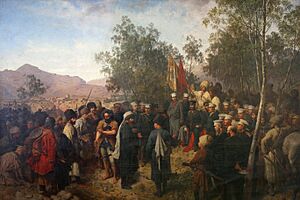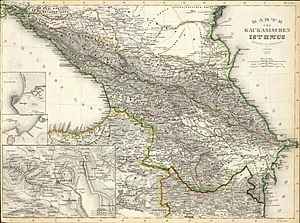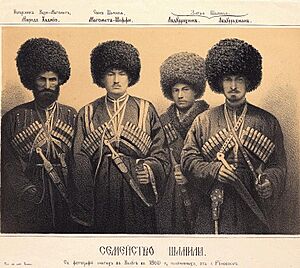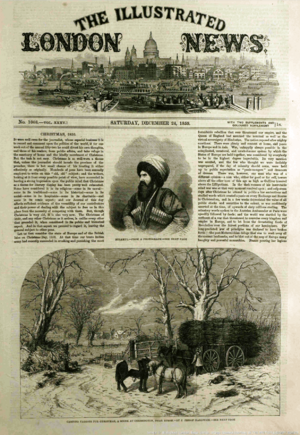Imam Shamil facts for kids
Quick facts for kids Imam Shamil |
|
|---|---|
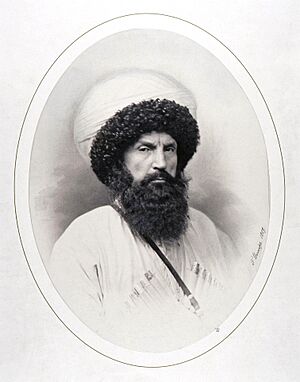
Shamil in 1859
|
|
| Imam of Chechnya and Dagestan | |
| Reign | 1834–1859 |
| Predecessor | Hamzat Bek |
| Successor | Overthrown by the Russian Empire |
| Born | 26 June 1797 Gimry, Dagestan, Avar Nutsaldom |
| Died | 4 February 1871 (aged 73) Medina, Habesh Eyalet, Ottoman Empire |
| Burial | Jannatul Baqi, Medina |
| Father | Dengau |
| Religion | Sunni Islam |
| Signature |  |
Imam Shamil (Arabic: الشيخ شامل; Avar: Шейх Шамил; Chechen: имам Шемал; Kumyk: Шамил; Russian: Имам Шамиль; born June 26, 1797 – died February 4, 1871) was a very important leader in the Caucasus region. He was a political, military, and spiritual leader who led the people of the North Caucasus against the Russian Empire in the 1800s.
Shamil was the third Imam of the Caucasian Imamate from 1840 to 1859. An Imam is a spiritual leader in Islam. He was also a Sunni Muslim sheikh of the Naqshbandi Sufis, which is a type of Islamic spiritual group.
Contents
Early Life and Family
Imam Shamil was born in 1797 in a small village called Gimry. This village is in what is now Dagestan, Russia. His family belonged to the Avar people. Some stories say his father's family might have been Kumyk.
He was first named Ali, but his name was changed to Shamuyil when he got sick. This was a local tradition. People in the Caucasus pronounced this name Shamil.
His father, Dengau, was a landlord. This allowed Shamil and his friend Ghazi Muhammad to study many subjects. They learned Arabic and logic, which helped them become smart leaders.
Shamil grew up when the Russian Empire was expanding. Russia was taking over lands that belonged to the Ottoman Empire and Qajar Iran. Many people in the Caucasus joined together to fight against Russia. This long fight became known as the Caucasian War (1817-1864).
Earlier leaders of this resistance included Hadji-Dawud and Sheikh Mansur. Shamil became a student and advisor to Ghazi Mollah, who was a childhood friend.
Shamil had a wife named Anna Ivanovna Ulukhanova. She was from Armenia and was captured in 1840. She later married Shamil and became a Muslim, taking the name Shuanet. Shuanet stayed loyal to Shamil even after he was captured. After Shamil died, she moved to the Ottoman Empire.
Leading the Fight Against Russia
In 1832, Ghazi Mollah died in a battle in Gimry. Shamil was one of only two fighters who escaped, but he was badly hurt. He was stabbed with a bayonet. He managed to escape by jumping over soldiers and fighting them off.
Everyone thought Shamil was dead, but he went into hiding to recover. Once he was well, he rejoined the fighters, who were then led by the second Imam, Hamzat Bek. Shamil would fight against the Russians for the next 25 years. He became a legendary leader of guerrilla warfare.
When Hamzat Bek was killed in 1834, Shamil became the new leader. He was the third Imam of the Caucasian Imamate.
The Siege of Akhoulgo
In 1839, Shamil and about 4,000 of his followers were surrounded. They were in their mountain stronghold called Akhoulgo. The Russian army, led by General Pavel Grabbe, attacked them. Shamil had used a "scorched-earth" strategy, meaning he burned supplies so the Russians couldn't find food.
The stronghold was naturally protected on three sides, making it hard to attack. Eventually, both sides agreed to talk. Shamil gave his son, Jamaldin, as a hostage to show he was serious. But Shamil refused to surrender or leave the region.
The Russian army then attacked Akhoulgo. After two days of fighting, they took the stronghold. Shamil managed to escape during the first night of the attack. Many local leaders then promised loyalty to the Russian Tsar. Shamil fled to Chechnya, where he quickly gained influence over the local clans.
Shamil's Tactics and Challenges
Shamil was very good at uniting the different Caucasian tribes. These tribes often argued among themselves. He used his strong personality, religious faith, and fair use of Islamic law (Sharia) to bring them together. One Russian person described him as "a man of great tact and a subtle politician."
Shamil believed that Russia bringing alcohol to the area was ruining their traditional values. He used clever, irregular fighting methods against the large Russian army. These were called guerrilla tactics.
In 1845, a large Russian army column, led by Count Mikhail Vorontsov, followed Shamil's forces into the Chechen forests. Shamil's fighters surrounded the Russian column and defeated it. This stopped Vorontsov's plan to separate Chechnya from Shamil's control.
Shamil is showing great activity this year and he is forced to do this, since we ... are taking measures that must sooner or later ... destroy his influence and tear away the Chechens from him, without which he will be nothing.
Shamil's military success grew when Hadji Murad joined him in 1841. Hadji Murad had left the Russians. He quickly helped Shamil triple the area under his control. Hadji Murad later became famous in a book by Leo Tolstoy. However, Hadji Murad later turned against Shamil. He was upset because Shamil chose his elder son to be the next Imam, not him. Hadji Murad then rejoined the Russians.
Shamil hoped that Britain, France, or the Ottoman Empire would help him fight Russia. But this never happened. After the Crimean War, Russia focused even more on defeating Shamil. Russian forces took back much of Shamil's territory. In September 1859, Shamil finally surrendered. Even though the main fighting ended, conflict continued in the eastern Caucasus for several more years.
Later Years and Legacy
After his capture, Shamil was taken to Saint Petersburg to meet Tsar Alexander II. Then, he was sent to live in Kaluga, a small town near Moscow. After a few years, he complained about the cold climate. In 1868, he was allowed to move to Kyiv, a larger city.
In Kyiv, Shamil lived in a nice mansion. The Russian authorities watched him, but not too strictly. They also gave the city money to support him. Shamil seemed to enjoy his comfortable life there, as shown in his letters.
In 1859, Shamil wrote to one of his sons: "By the will of the Almighty... I have fallen into the hands of unbelievers... the Great Emperor... has settled me here... in a tall spacious house with carpets and all the necessities."
In 1869, Shamil was allowed to go on the Hajj, a pilgrimage to the holy city of Mecca. He traveled from Kyiv to Odesa, then sailed to Istanbul. There, he was welcomed by the Ottoman Sultan Abdulaziz. He stayed at the Imperial Topkapı Palace for a short time.
In Mecca, he met and talked with Abdelkader El Djezairi, another famous resistance leader. After his pilgrimage, Shamil died in Medina in 1871 while visiting the city. He was buried in Jannatul Baqi, a historic graveyard in Medina where many important Islamic figures are buried.
Shamil's two elder sons, Cemaleddin and Muhammed Şefi, stayed in Russia and became officers in the Russian army. His two younger sons, Muhammed Gazi and Muhammed Kamil, served in the Turkish army. His daughter Peet'mat Shamil married Sheikh Mansur Fedorov.
Said Shamil, one of Imam Shamil's grandsons, helped create the Mountainous Republic of the Northern Caucasus. This republic was formed in 1917 and lasted until 1920, when it was taken over by Soviet Russia. Said Shamil later moved to Germany and started the "Committee of Independence of the Caucasus" in 1924.
Shamil's Legacy
Even though Russia conquered Chechnya and Dagestan, Russians developed great respect for Shamil. Tsar Alexander II of Russia openly admired his strong resistance. Because of this, Shamil was allowed to go on the Hajj later in his life.
Shamil's life and actions are still studied by Russian experts today. An insect scientist even named a large swift moth after him.
Musical Composition
In 1958, a religious leader named the Lubavitcher Rebbe shared a story about a tribal leader named Shamil. This Shamil was fighting against Russian forces. He was captured and exiled after being tricked by a false peace treaty.
During his exile, Shamil created a sad song without words. This song expressed his rise, his downfall, and his wish for freedom. This song was later adopted by the Chabad movement. They saw a deeper meaning in it, comparing it to the human soul. They believe the soul comes to the world, gets trapped in a body, but knows it will one day return to its creator.
See also
- Caucasian War
- Russian conquest of Chechnya and Dagestan
- Russo-Circassian War
- Murtazeki
- Sayyid Abdurrahman


